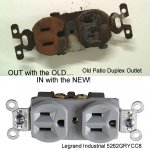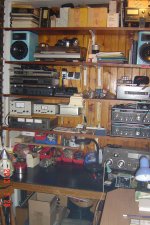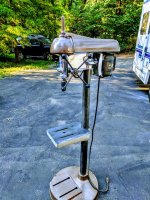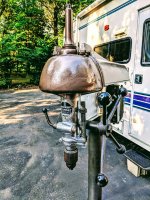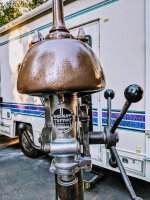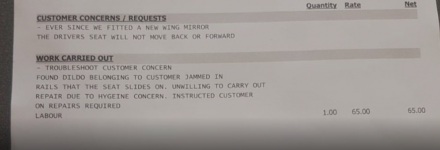Yes it does help.Hi Nigel,
I think you will find that liquid solder flux makes your life a great deal easier for stuff like that.
-Chris
I also found some flux paste under the chip holds it in place while I make the first solder joint.
The chip is on TQFP 0.5mm pitch so is fun to solder. Lining it up with pcb pads is first challenge, definitely a magnifying glass job.
I start by soaking in flux then run soldering iron along one each of the chip.
That usually ends up with all pins shorted so I put plenty of flux down and use copper braid to remove excess solder.
Hi Nigel,
I normally apply the flux as you've mentioned, and also using a brush to put a little bit across the top of the pins. I tack pins across the package first and check alignment, then run the iron with solder along the row of pins. But, I cheat. I use a 3mm screwdriver type tip. Sometimes the last pins are shorted, but cleaning the tip, then touching the two pins will draw the solder away. Then clean with lacquer thinner. Most times the end result looks like a factory job.
-Chris
I normally apply the flux as you've mentioned, and also using a brush to put a little bit across the top of the pins. I tack pins across the package first and check alignment, then run the iron with solder along the row of pins. But, I cheat. I use a 3mm screwdriver type tip. Sometimes the last pins are shorted, but cleaning the tip, then touching the two pins will draw the solder away. Then clean with lacquer thinner. Most times the end result looks like a factory job.
-Chris
The electrical outlet on my patio had issues.
Plugs wouldn't stay in properly - making the job of mowing the lawn a big job.
A normal 20 minute job, turned into TWO HOURS... because the retaining screws were rusted, and one snapped off in the housing.
Had to drill it out and re-tap for a new 6/32 screw.
I chose the Legrand Industrial outlet because of its durability.
Installed a new water-seal gasket, caulked with some permatex, it's DONE!
Whew!
Plugs wouldn't stay in properly - making the job of mowing the lawn a big job.
A normal 20 minute job, turned into TWO HOURS... because the retaining screws were rusted, and one snapped off in the housing.
Had to drill it out and re-tap for a new 6/32 screw.
I chose the Legrand Industrial outlet because of its durability.
Installed a new water-seal gasket, caulked with some permatex, it's DONE!
Whew!
Attachments
agreed. Another trick that worked for me is "flooding" the pins with solder. And afterwards "draining" the solder with the soldering iron.Hi Nigel,
I think you will find that liquid solder flux makes your life a great deal easier for stuff like that.
-Chris
That old outlet sure looks beat. Hope the new one lasts awhile!The electrical outlet on my patio had issues.
That old outlet sure looks beat. Hope the new one lasts awhile!
Yeah, the old outlet was likely put in in the 1970's, not sure, I've only been the homeowner for 15 years now.
It's seen its use, plenty, mainly for the lawn/garden equipment.
The new one is supposed to be designed for "heavy shop useage", such as in busy machine/auto repair shops and such.
I made a little SMD pcb for a A2D AD9200.
It was as fiddle to solder as its on 0.65mm pitch.
Sadly didn't work when connected to the motherboard.
For some reason analogue input was good but no databus activity.
So in desperation I re-soldered one side of SMD device.
Still didn't work.
So re-soldered other side and it burst into life.
I suspect the VCC pin hadn't soldered well and wasn't powering up the device.
I found the trick with SMD IC's is to dab some flux paste beneath them to hold them in place before attempting to solder them. Then line it up exactly. Then just run a little solder up the corner pad to hold it in place. Then solder other side. I then remove any excess solder with copper braid.
It was as fiddle to solder as its on 0.65mm pitch.
Sadly didn't work when connected to the motherboard.
For some reason analogue input was good but no databus activity.
So in desperation I re-soldered one side of SMD device.
Still didn't work.
So re-soldered other side and it burst into life.
I suspect the VCC pin hadn't soldered well and wasn't powering up the device.
I found the trick with SMD IC's is to dab some flux paste beneath them to hold them in place before attempting to solder them. Then line it up exactly. Then just run a little solder up the corner pad to hold it in place. Then solder other side. I then remove any excess solder with copper braid.
Had an op amp and 74HC4051 circuit misbehave.
On the 1:1 range it should be 1 volt in and 1 volt out but I was getting two volts out.
First thought was resistors were wrong but they checked ok.
Checked select pins on 4051 and the voltages were correct.
So changed 4051 and it worked fine, a very rare faulty new IC.
On the 1:1 range it should be 1 volt in and 1 volt out but I was getting two volts out.
First thought was resistors were wrong but they checked ok.
Checked select pins on 4051 and the voltages were correct.
So changed 4051 and it worked fine, a very rare faulty new IC.
80 year old drill press
Walker Turner drill press... was covered with rust and grime, bearings seized, etc... rebuilt from scratch... looks like an alien and runs great. Heavy as hell!
Walker Turner drill press... was covered with rust and grime, bearings seized, etc... rebuilt from scratch... looks like an alien and runs great. Heavy as hell!
Attachments
Walker Turner drill press... was covered with rust and grime, bearings seized, etc... rebuilt from scratch... looks like an alien and runs great. Heavy as hell!
3/8" chuck?
3/8" chuck?
I have several different sizes, but yes, it's a 3/8" chuck in the pics
This was posted on "The Irish Post" -- a repair not made:
And here all this time I thought texting while driving was a bad thing to do...
A nice McIntosh MR74.
It went to a different tech who pretty much made it irreparable. We needed a parts unit to replace the destroyed parts (an RF inductor and an RF transformer in the MPX section). Once those parts were replaced we were back to the original fault. But before that, that other tech had tuned the IF strip to 10 MHz! It should be 10.7 MHz of course, and several other silly things. The last part needed was the opto-coupler. Installed that part (a sunstitute) and it began to work perfectly. I'm just going to go over the alignment again to make sure everything is bang on. The customer didn't expec to ever get it back repaired after the first guy was done.
-Chris
It went to a different tech who pretty much made it irreparable. We needed a parts unit to replace the destroyed parts (an RF inductor and an RF transformer in the MPX section). Once those parts were replaced we were back to the original fault. But before that, that other tech had tuned the IF strip to 10 MHz! It should be 10.7 MHz of course, and several other silly things. The last part needed was the opto-coupler. Installed that part (a sunstitute) and it began to work perfectly. I'm just going to go over the alignment again to make sure everything is bang on. The customer didn't expec to ever get it back repaired after the first guy was done.
-Chris
Just unplugged the bathroom sink drain with a left over piece of 12 gauge electrical wire, perfect for it, better that the more common 14 gauge.
But as most are probably interested in electronics, the last of that was a satellite receiver that needed a new NVRAM chip. As the only SMD that I have soldered recently, I know that I need some kind of vision aid, as I was mostly on a wing and a prayer. All for nought, as my stupid satellite provider refuses to send me a current subscription card for it, fight as I might.
But as most are probably interested in electronics, the last of that was a satellite receiver that needed a new NVRAM chip. As the only SMD that I have soldered recently, I know that I need some kind of vision aid, as I was mostly on a wing and a prayer. All for nought, as my stupid satellite provider refuses to send me a current subscription card for it, fight as I might.
I'm currently investigating a transformer we have that is (was) running our US spec clothes-dryer. It was fabricated some 14 years ago to use Argentinian 220V, (no grounds), to US common-household 220V.
It did one of those flame-on things...I haven't yet found out if it is a true twin-coil transformer, or just an auto-transformer. Fortunately the laminations weren't all glued together..a conventional E I lams...but the whole core is a whopping 160mm by 192mm per E I lamination...stacked 120mm "high".
Once I get all the laminations out, I'll be assessing the core damage.
---------------------------------------------------------------------Rick.........
It did one of those flame-on things...I haven't yet found out if it is a true twin-coil transformer, or just an auto-transformer. Fortunately the laminations weren't all glued together..a conventional E I lams...but the whole core is a whopping 160mm by 192mm per E I lamination...stacked 120mm "high".
Once I get all the laminations out, I'll be assessing the core damage.
---------------------------------------------------------------------Rick.........
- Home
- Member Areas
- The Lounge
- What did you last repair?
